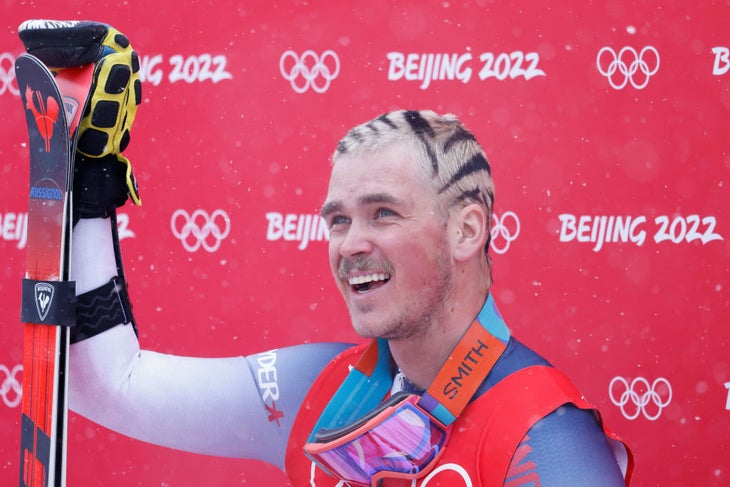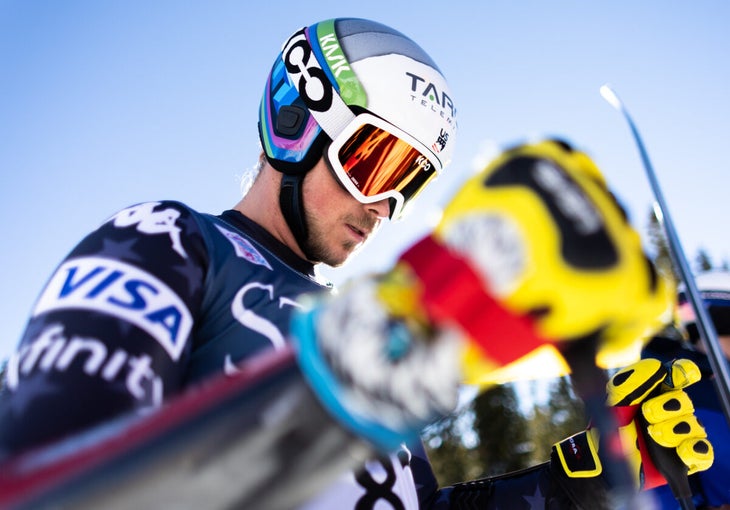Products You May Like
At the 2022 Beaver Creek World Cup super-G last weekend, River Radamus gave U.S. ski-racing fans something to cheer about. The 24-year-old alpine racer started fifth from last with bib 57 and ended up finishing 16th, the only American to finish in the top 30. The crowd went wild for their native son. Radamus was born and raised in the Vail Valley, and he had just scored his first super-G World Cup points.
After the race, he felt “electric,” he said—an emotion that, in a way, matched the hot pink hair peeking out from under his helmet.
Until the 2022 Olympics last winter, where Radamus finished an astonishing fourth in giant slalom, he was known as a promising GS specialist who rocked wild hairstyles. In 2021, he showed up for the Sölden World Cup with a leopard print dye job—then finished sixth in that season-opening GS. For the Beijing Games, he debuted a zebra pattern. This year, he’s rocking flowers dyed into a hot pink buzz cut. The fun hair helps remind him “not to take it all too seriously.” But at the same time, he doesn’t want his crazy manes to overshadow his skiing.

Last winter was a breakthrough season for Radamus. In addition to his fourth place in GS in Beijing, he also scored three top-10 World Cup finishes. Some even started calling Radamus the next “Mr. GS,” the nickname given to Ted Ligety a decade ago when he dominated GS races by huge margins.
Related: River Radamus and other young talent leap up the U.S. Ski Team ranks after banner performances
Radamus refuses to don that mantle though. He knows that “there’s only one Mr. GS.”
“Ted was an absolute master of the craft,” Radamus explained. “He perfected the style more than anybody ever has and took pride in the details.”
What Radamus hopes to do is carry on the legacy of great American GS skiers—like Ligety, Bode Miller, and Tommy Ford. Following in their tracks is “something that I can take on more readily than the title of Mr. GS,” noted Radamus.
Read more: Who will be the next Ted Ligety? We asked Ted Ligety
While he’s now making a name for himself in giant slalom, Radamus did not set out to be a GS master. He aspired to ski all events—from slalom to downhill—like Miller and most recently, Mikaela Shiffrin.
“I love all the events, they’re all my children,” he said. “But I would say that GS is my favorite child.”
Why? Because like Ligety, Radamus is all about the turn—the feeling of the ski on snow powering up a perfect arc.
Shiffrin has known Radamus since he was a baby, both having grown up in Vail, and calls him a beautiful skier. “He has a natural feel for skiing, for the snow, for the radius of his skis,” she said.
Radamus also has GS in his genes. His mom, Sara Radamus (nee McNealus), grew up ski racing in Vermont and as a senior at Middlebury College, was the 1979 collegiate national women’s GS champion. She later became a coach. And dad Aldo Radamus is best known as a ski coach for both the U.S. Ski Team and Ski & Snowboard Club Vail. Under his watch as head technical coach for the U.S. Ski Team in the 1980s, the U.S. women almost swept the GS podium at the 1985 world championships.
After their son was born in February 1998, the Radamuses brought little River out on the hill when they coached. Unable to easily carry both a baby and the tools needed for coaching (gates, drills, timing equipment, etc.), they put him on skis before he could walk.
“It was easier for them to push me around that way,” said Radamus.
Immersed in skiing every winter, Radamus developed a preternatural feel for the snow. His international breakthrough came the day after his 18th birthday. At the 2016 Youth Olympic Winter Games in Lillehammer, Norway, he became the first athlete to win a trifecta of gold medals at the YOG, winning the GS, super-G, and combined. Then, from 2017-2019, Radamus won four medals at World Junior Championships, including double gold in 2019 (GS and super-G).
But his transition to the World Cup ranks was not as smooth as his carved turns. In his first three seasons on the World Cup, starting in December 2017, he DNFed (did not finish) or DNQed (did not qualify for a second run) in 82 percent of the World Cups that he entered.
Radamus blames the tough transition on his early success in the junior ranks.
“I didn’t take enough pride or due diligence to fulfill every step in my progression as an athlete,” he explained. “[As a junior], I was able to take shortcuts in my conditioning and mental preparedness and other details that make me a complete racer. I was having success, so it didn’t seem necessary.”
At the World Cup level, Radamus realized that his competition was just as skilled and talented as he was, except most of them had done the extra work to reach that level. So Radamus spent summer 2021 pushing his limits in training and shifted his mindset. He embraced the details and the work required to compete at the highest level. It paid off immediately. He finished sixth in the 2021 Sölden GS, then sixth again in Alta Badia, Italy, two months later. His confidence jumped up a few notches, and he became more at ease on tour and more hungry for success.

“The seasons prior, I felt like I was on the outside looking in, I was a participant, not a competitor,” he said. “Last year, I generally felt like a competitor.”
His teammates noted his progress—and the work that it took to get there. Shiffrin was impressed that he addressed “a few of the pieces that seemed to hold him back.”
“To me, that’s the sign of a skier who has the potential to be successful and be a mature skier,” she said.
“He does have to work on his hairstyle though,” joked Shiffrin, who is not a fan of this year’s design.
Radamus’s fourth place in the 2022 Olympic GS, while tough to swallow, was an exclamation point on his season. His friends gave him a chocolate medal.
“It was bittersweet chocolate,” he said with a wry smile.
But his good results have had a sweeter side. With growing fame, he is starting a foundation to help financially disadvantaged skiers.
In the immediate future, Radamus plans to ski more super-G this year, in addition to GS and parallel events. He competed in super-G at the 2022 Olympics, finishing 15th, then trained the discipline in Chile this fall. The recent Beaver Creek race was only the eighth World Cup super-G he has competed in. Look for him to capitalize on his Beaver Creek performance in the coming men’s World Cup giant slalom in Val d’Isere, France on Dec. 10.
“Deep down, I’m just a racehorse,” he said. “I love to get into the start gate as many times as I can.”
As for a nickname, Radamus could be called the German version of Mr. GS, “Herr GS.” Or better still, “Hair GS.”
More from World Cup racing
Mikaela Shiffrin and teammates reveal their favorite and most-dreaded World Cup courses
Our fantasy ski team is the team to beat all fantasy ski teams
U.S. to host two additional World Cup races in 2023
